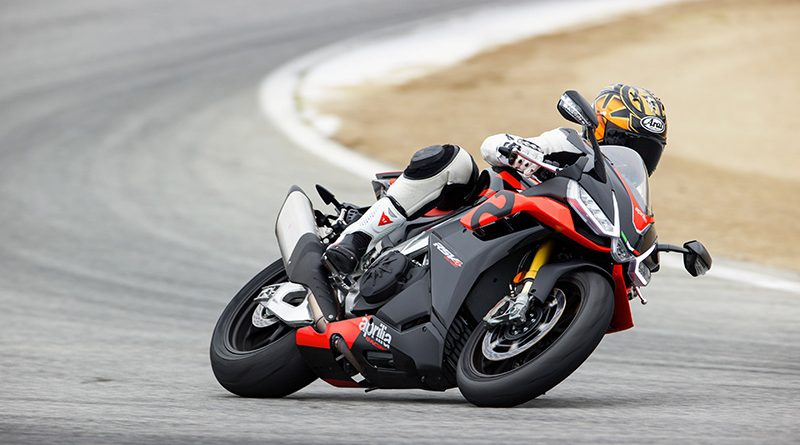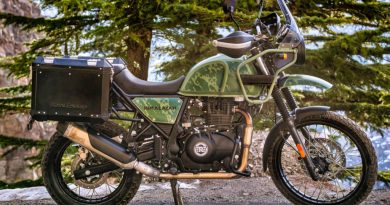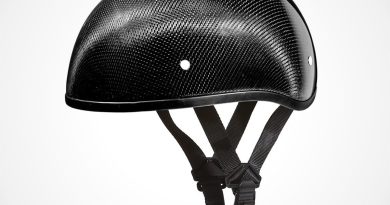2021 Aprilia RSV4 Factory | First Ride Review
The 2021 Aprilia RSV4 and RSV4 Factory (above) were completely redesigned. (Photography by Larry Chen Photo)
Aprilia’s RSV4 is a bike that, like a fine wine, only gets better with age. Racing has always been a driving factor in the design of Aprilia’s sportbikes. The RSV4 was introduced for 2009 to compete in World Superbike, and Max Biaggi stood atop the podium nine times that season and won the championship in 2010. Four years later, the RSV4 was ridden to another WSBK championship by Sylvain Guintoli.
With racing in its DNA, it’s only natural that advancements made on the track influence design and engineering of models ridden by the general public, from advanced electronics to downforce-producing bodywork. The Aprilia RSV4 and RSV4 Factory underwent a ground-up redesign for 2021, giving us an opportunity to see how this racy red Italian wine tastes a decade on.
2021 Aprilia RSV4 Factory in Aprilia Black (left) and 2021 Aprilia RSV4 in Dark Losail (right).
It’s been a few years since I through a leg over a RSV4, so I was interested to see how the folks back in Noale, Italy, improved an already great motorcycle. And what better place to stretch its legs than the legendary WeatherTech Raceway Laguna Seca in Monterey, California, home of the famous Corkscrew. Laguna Seca has a long history of Superbike racing, plus it’s a favorite track for many of us. If only the fog weren’t so cold and damp, conditions would have been perfect.
Before we get to how the bikes work, let’s take a look at what’s new. Last year, Aprilia’s two RSV4 models had engines with different displacements, with the FIM-homologated RSV4 1100 RR boasting 1,000cc (and a claimed 201 horsepower) and the RSV4 1100 Factory living up to its name with 1,077cc (and 217 horsepower). Aprilia simplified things for 2021, equipping the RSV4 and RSV4 Factory with the same 1,099cc, 65-degree V-4 engine — with an extra 22cc of displacement courtesy of a slightly longer 53.3mm stroke, up from 52.3 — that Aprilia says still cranks out an eye-watering 217 horsepower at 13,000 rpm and 92 lb-ft of torque at 10,500 rpm, even while meeting strict Euro 5 emissions regulations.
The V-4 architecture allows the engine to be narrow while still offering the power-producing benefit of four cylinders. To keep the engine as light as possible, the crankshaft was made lighter and the external housings, oil sump and cylinder head covers are made of magnesium. To keep the engine as compact as possible, the cam chain drives the intake camshaft and a gear on the intake camshaft drives the exhaust camshaft. To maximize the engine’s rigidity, the crankcase is a monoblock design with integrated aluminum cylinder liners. And to minimize vibration, a countershaft cancels out engine imbalances. A new Magneti Marelli ECU 11MP allows more complex algorithms to be processed at a faster speed, and a new exhaust system not only satisfies Euro 5 but is lighter than its predecessor.
With well over 200 horsepower on tap, electronics allow the riding experience on the RSV4s to be tailored the rider’s skill level and preferences. Guided by a Bosch 6-axis IMU, the APRC (Aprilia Performance Ride Control) suite does crazy fast calculations to optimize the bike’s dynamic behavior while offering a wide range of adjustability. Fifth-generation APRC includes: ATC (Aprilia Traction Control, 8 levels adjustable on the fly), AWC (Aprilia Wheelie Control, 5 levels adjustable on the fly), AEM (Aprilia Engine Map, 3 to choose from), AEB (Aprilia Engine Brake, a new feature with 3 levels that take lean angle into account), ALC (Aprilia Launch Control, 3 settings for track use), AQS (Aprilia Quick Shift), APL (Aprilia Pit Limiter) and ACC (Aprilia Cruise Control). Everything comes together with the six riding modes, with three for the street (Street, Sport and customizable User) and three for the track (Race and customizable Track 1 and Track 2).
That hardworking IMU also provides input for the Bosch 9.1 MP cornering ABS, which ensures maximum safety on the road and exceptional performance on the track. Co-developed between Aprilia and Bosch, it offers three levels of intervention and works in conjunction with Aprilia RLM (Rear Lift Mitigation) to keep the rear tire on the ground during hard braking.
We’re not done yet.
Whereas the standard RSV4 features fully adjustable Sachs suspension, the RSV4 Factory is equipped with Öhlins Smart EC 2.0 semi-active suspension, with a 43mm NIX upside-down fork, a TTX rear shock and an electronic steering damper. An array of sensors and servo motors adjust compression and rebound damping automatically as you ride, adapting to changing conditions. There are two modes — semi-active and manual — and three suspension maps for each mode, and Öhlins’ OBTi (Objective Based Tuning Interface) simplifies pushbutton adjustments. Both RSV4 models are perfectly capable of delivering effective feel and control in any situation, but the standard RSV4 requires manual changes while the Factory’s setup can be changed on the fly with the touch of a button (preload must be manually adjusted on both models).
Perhaps it goes without saying that the RSV4 is smarter than I am. I’ve done a lot of racing over the years, including the Isle of Man TT, back when control was all in the wrist and I had to rely on my own brain rather than the motorcycle’s to keep me out of trouble. But things can and do go wrong from time to time, and I have come to appreciate not only the helping hand but also the convenience and customization that modern electronics provide.
Because most changes can be made on the fly, I was able to try out various setups without having to return to the paddock. Pressing a button on the right cluster below the kill switch changes the riding mode, while a four-button setup on the left makes adjustments within each mode. A lever on the bottom of the left cluster adjusts traction control, and a switch on the top of the left cluster adjusts both cruise control and wheelie control. There wasn’t much cruising going on at Laguna Seca, but there were plenty of wheelies that needed to be tamed! And a new 5-inch full-color TFT display, which offers Road and Track screens, provides an easy-to-read mission control.
Aprilia revised the RSV4’s chassis and bodywork as well. To optimize strength, rigidity and feedback, the twin-beam aluminum frame uses both cast and pressed-and-welded elements. The cast aluminum swingarm has a new lower reinforcing brace for added stiffness and uses three welded sections instead of seven, reducing unsprung weight by 1.3 pounds. Unique among production sportbikes is the degree of adjustment possible with the RSV4’s chassis, including engine position, headstock angle, swingarm pivot and rear ride height. Chassis geometry has been tweaked slightly to improve handling, and to keep mass centralized mass, most of the RSV4’s fuel is carried under the rider’s seat.
Inspired by the Aprilia RS 660, the new RSV4 is more aerodynamic, with revised bodywork, a larger windscreen and new winglets built into the double-wall fairing that provide more wind protection for the rider, more downforce and a 7% increase in airbox pressure. Revisions to the lower cowling help improve cornering agility and reduce cross wind buffeting. A new fuel tank provides more support during braking and cornering and has a deeper chin perch for getting behind the windscreen when fully tucked in. Seat height was reduced by 9mm and the footpegs were lowered by 10mm, yet cornering clearance increased by 1.5 degrees on both sides thanks to narrower pegs. All this adds up to a more comfortable cockpit, especially for someone my size (5 feet, 10 inches).
The RSV4 has always been a looker, and the new bodywork only enhances its go-fast, form-follows-function stance. The front lighting application is what really stuck out to me. New DRL light rails that run under and up the sides of the LED cat-eye headlights really make it pop, and cornering lights add visibility during nighttime riding. And the exhaust muffler looks the business. The Factory is available in either Lava Red or Aprilia Black (shown), while the standard RSV4 comes in Dark Losail. The Factory also rolls on light, strong, five-spoke forged and machined aluminum wheels rather the three-spoke cast aluminum wheels on the standard model.
After a few laps on the RSV4 Factory I realized this bike is seriously fast. The smooth nature and low growling sound of the V-4 were deceptive, making me think I was going slower than I actually was. With 80% of peak torque available in the midrange, you don’t have to rev the engine into the stratosphere to get a strong pull out of corners. And it continues to pull even harder as the revs pick up heading down the straight to the next corner. The new Brembo Stylema monoblock radial front calipers paired with 330mm rotors were perfectly capable of slowing things down. Front brake action was superb, allowing me to modulate the needed pressure to control corner entry with plenty of feel and braking power.
I started the day in Race mode, which had a rather abrupt throttle response, but switching to Street mode smoothed things right out. As the day progressed, I ended up back in the Race and Track modes because, once I found my groove, it’s never fast enough, right? Unlike the Track modes, the three road-going modes tame power delivery for everyday riding, like commuting (don’t forget the cruise control!) or riding through town on your way to the good stuff, with the APRC electronics on standby in the background.
In terms of handling, the RSV4 and RSV4 Factory are perfectly suited to a challenging track like Laguna Seca. The RSV4 has always offered positive feedback to the rider, and the latest iteration is even better, allowing me to attack corners with complete confidence. Leaned over in the middle of a corner, the bike felt planted and told me exactly what was going on. Under hard braking the RSV4 never got out of shape, and with three levels of engine braking I could explore how much to let the rear step out.
I managed to get the RSV4 out of shape a few times on hard exits, especially coming out of Turn 2. The bike started to lift the front and I could feel the rear starting to let go, but before things went pear-shaped the wheelie control and traction control kicked in and kept me from ending the day early. The quickshifter with auto-blip downshifting is almost like cheating; just move your foot and the shift is made up or down with no clutch and no hesitation (it’s adjustable too).
Although the RSV4 Factory performed exceptionally, I struggled with the bike squatting on hard corner exits. Since the day got off to a late start due to a foggy and damp morning, we lost some valuable track time. The bike I was on seemed a little out of balance front to rear, but more preload at the rear remedied the problem. Fine-tuning is part of the process when you’re trying to squeeze every bit of performance out of a race-ready sportbike.
For conoisseurs, Aprilia’s latest RSV4 and RSV4 Factory offer robust, full-bodied vintages suitable for different budgets and tastes. The standard RSV4 has an MSRP of $18,999, whereas the RSV4 Factory has an MSRP of $25,999, with the extra lira paying for the Öhlins Smart EC 2.0 semi-active suspension and primo forged wheels. Enjoy responsibly.
2021 Aprilia RSV4 Factory Specs
Base Price: $25,999
Website: aprilia.com
ENGINE
Engine Type: Liquid-cooled, transverse 65-degree V-4, DOHC w/ 4 valves per cyl.
Displacement: 1,099cc
Bore x Stroke: 81.0 x 53.3mm
Compression Ratio: 13.6:1
Horsepower: 217 @ 13,000 rpm (claimed)
Torque: 92 lb-ft @ 10,500 rpm (claimed)
Transmission: 6-speed, hydraulically actuated wet slipper clutch
Final Drive: Chain
CHASSIS
Frame: Aluminum dual-beam with pressed & cast sheet elements, cast aluminum swingarm
Wheelbase: 56.5 in.
Rake/Trail: 24.6 degrees/4.1 in.
Seat Height: 33.3 in.
Suspension, Front: 43mm USD fork, electronically adj., 4.9 in. travel
Rear: Single shock, electronically adj., 4.5 in. travel
Brakes, Front: Dual 330mm floating discs w/ 4-piston opposed radial monoblock calipers & ABS
Rear: Single 220mm disc w/ 2-piston caliper & ABS
Wheels, Front: Forged aluminum, 3.5 x 17 in.
Rear: Forged aluminum, 6 x 17 in.
Tires, Front: 120/70-ZR17
Rear: 200/55-ZR17
Wet Weight: 445 lbs. (claimed, 90% fuel)
Fuel Capacity: 4.7 gals.
The post 2021 Aprilia RSV4 Factory | First Ride Review first appeared on Rider Magazine.




